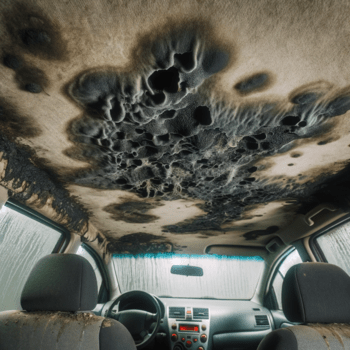

by Dr Diane Mueller – Mold in cars? Yep, it’s a thing. While many believe in testing everything for mold when dealing with mold illness, it’s not always necessary to go to extremes. But hey, don’t underestimate the sneaky nature of mold, especially if you’re in a humid area and spend loads of time in your car.
In this article, I’ll walk you through the essential steps to remove mold from your car effectively. We’ll cover everything from the initial clean-up to the nitty-gritty of mold removal, ensuring your car is safe and pristine. So let’s dive into how you can turn your car back into your clean sanctuary it should be.
We have helped thousands of people restore their health and quality of life by diagnosing and treating their Mold Illness
When addressing the issue of mold in your car, understand toxic black mold isn’t something to take lightly. Microscopic mold spores, not visible to the naked eye, can invade your vehicle’s interior, and when they do, they aren’t just an unsightly nuisance; they can be a serious health hazard. These spores can lead to symptoms like sneezing, coughing, and in more severe cases, conditions such as chronic fatigue or respiratory issues.
Mold thrives in small, enclosed spaces making your car a prime breeding ground, especially if you’ve experienced flood damages or have a habit of leaving damp items, like gym clothes or umbrellas, lying around. High humidity levels can go unnoticed in a car’s interior but can have devastating effects over time as mold begins to take hold.
Getting rid of mold isn’t just about maintaining the value of your car; it’s about safeguarding your health and that of your passengers. A car with a mold problem can become a moving petri dish of sorts, with continuous circulation of spores each time you turn the air conditioning or heat on. This is a problem that, if ignored, continues to grow—both in scope and potential risk.
A DIY approach to mold removal can be effective for minor infestations, but in more severe cases, it might be wise to consult a mold remediation expert. These professionals have the tools and skills to assess and rectify the issue thoroughly, ensuring your car’s safety and your peace of mind. Getting ahead of the problem before it worsens is crucial because as mold spreads, the more challenging and costly it can be to eradicate.
Recognizing the warning signs of mold in your car is critical for maintaining a clean and healthy environment. Mold, particularly toxic black mold, can pose health risks such as chronic fatigue if not addressed promptly. Spotting mold early on can save you from costly cleanups or the need for a mold remediation expert later.
When you suspect mold car, the first thing to do is conduct a thorough inspection. Mold isn’t always immediately visible; sometimes the first hint is a musty or sour milk-like odor. Microscopic mold spores can be present, waiting for the right conditions to proliferate. If your car’s been through flood damages or if you’ve left damp items like gym clothes or wet shoes inside, the risk of mold growth increases.
After identifying signs of mold, I’ll move on to determine the best course of action for removal. It’s important to tackle this problem head-on to ensure my vehicle remains a safe place for me and my passengers.
Before diving into the mold removal process in your car, it’s crucial to gear up properly to protect yourself from potential health risks. Toxic black mold, although not always present, could be mixed in with other Microscopic mold spores, making safety gear indispensable.
Should You Call a Professional to Remove Mold in Car?
When faced with mold in your car, it’s vital to assess whether you can tackle the issue yourself or if you need to call in a mold remediation expert. Toxic black mold, for instance, is not a DIY project. It poses serious health risks, and mold remediation specialists are trained to handle such dangers properly.
In many cases, the signs that DIY efforts might not suffice are clear. You might notice the weatherstripping along your car doors becoming brittle or flaking due to mold damage or a distinct moldy odor that persists after thorough cleaning. When mold keeps coming back despite repeated efforts, it’s time to consider professional help.
If you’ve experienced flood damages in your car, the likelihood of a mold issue extends far beyond the surface. In such instances, mold infestation can penetrate deep into upholstery and insulation, requiring specialized equipment and techniques that only professionals can provide.
Remember, before hiring a professional, check their background to guarantee they have the requisite experience with car mold. The benefits of hiring a professional include:
Specialized knowledge of different mold types
Access to industrial-grade cleaning agents and tools
Expert techniques to prevent future mold growth
Your health and the longevity of your vehicle are paramount. When in doubt, it’s wise to reach out to a mold remediation expert. They can thoroughly address the mold problem, making your car safe once again.
I’ve found that using non-iodized salt is a clever, budget-friendly method for tackling mold in car interiors. Saltwater dehydrates mold spores, effectively starving and killing them. Here’s my approach:
Vacuum the area first to remove surface mold.
Then mix a concentrated salt solution in a bucket of water.
After applying the solution generously to mold-infected spots, leave the car under direct sunlight.
Once a crust forms, wipe it off with water or vacuum again.
Remember, although this method is effective, be cautious using it on delicate materials like leather, which may suffer from the corrosive nature of salt.
When it comes to mold removal, white vinegar is my go-to fix. It’s the acidity that does the trick, eradicating those pesky microscopic mold spores and ensuring they’re unlikely to make an unwelcome return. My steps are straightforward:
I dilute the white vinegar with water, unless I’m dealing with exceptionally moldy spots.
Then, using a spray bottle or cloth, apply the solution to the moldy areas.
After allowing the vinegar mixture to sit for about 20 minutes, lightly scrub the spots.
A wet-and-dry vacuum is perfect for picking up dead mold.
Even though the potent vinegar odor is a drawback, it’s nothing an air freshener or open doors can’t address, helping the smell to dissipate.
Surprisingly, clove oil has anti-fungal properties, making it an effective alternative for mold remediation. For best results:
Dilute a teaspoon of clove oil in a spray bottle filled with water.
Spraying the mixture on mold-affected regions, leave it on for about 20 minutes.
Scrubbing off the dead mold and vacuuming thereafter ensures a mold-free car interior.
Experts suggest that clove oil can even disrupt toxic black mold growth, though caution is advised when dealing with such high-risk infestations.
Baking soda isn’t just for baking; it’s a fantastic mild alkali used for scrubbing away mold and neutralizing odors. Here’s the step by step:
Mixing a quarter tablespoon with water in a spray bottle, coat the moldy sections of the car.
After scrubbing with a brush, rinse or vacuum the area.
Baking soda has the added perk of absorbing moisture, which can prevent future mold outbreaks.
For those tougher mold problems, like flood damages or deep-set spores, opt for special cleaning agents. These can be picked up from a hardware store and usually contain stronger fungicides. Because of the health implications, including chronic fatigue, tied to mold exposure, actually contacting a mold remediation expert is something strongly suggested. They’re equipped with industrial-grade tools to safely eliminate mold and are trained to handle hazardous situations, especially when toxic black mold is in question.
Mold in a car not only looks and smells bad, but it can also result in health issues ranging from allergies to chronic fatigue. To keep mold at bay in your vehicle, follow these tips for a healthier auto environment.
Moisture is the primary factor behind mold growth in vehicles. Microscopic mold spores thrive in damp environments, creating the perfect storm for toxic black mold and other varieties to take hold. To tackle this, start by absorbing any excess moisture with desiccants like silica gel packets or even a bag of rice. These can be placed under seats or in other hidden areas to keep the interior dry. For persistent dampness, especially after flood damages, using a wet dry vacuum cleaner can effectively remove moisture from every nook of the car’s interior.
To reduce the risk of mold, I make it a habit to clean my car with an antimicrobial cleaner. Disinfecting your vehicle regularly is crucial, especially if you’re frequently traveling with passengers or pets. Target areas like the steering wheel, door handles, and HVAC system, as these are breeding grounds for bacteria and spores. When used in conjunction with thorough cleaning, disinfecting helps in maintaining a mold-free environment.
One simple measure to prevent moisture accumulation is to keep my windows rolled up, especially during bad weather. This action helps to keep out rain, which is a leading cause of dampness in car interiors. Remember, even a small amount of rain can create an environment conducive to mold growth, so it’s best to minimize exposure to the elements whenever possible.
For deeper cleaning, I employ a wet dry vacuum cleaner. It’s an effective tool for removing moisture trapped deep within the car’s upholstery and carpeting. By regularly using this type of vacuum, you ensure that even the most stubborn of moisture pockets are eradicated, effectively reducing the risk of mold setting in.
Finally, don’t overlook the importance of a clean air filter. A quality air filter helps trap mold spores before they can circulate through the car. It’s important to check and replace the air filter regularly, as a clogged filter can exacerbate the problem by spreading spores throughout the vehicle every time the air is turned on. Regular maintenance of the vehicle’s air filtration system not only clears the air of potential mold spores but also contributes to overall healthier air quality within the car.
Tackling mold in your car doesn’t have to be a daunting task. Armed with household items like salt, vinegar, and baking soda, you’ve got everything you need to address the problem at its root. Remember, it’s not just about the cleanup; it’s about staying vigilant against moisture and keeping your car’s interior dry. Regular disinfection and a clean air filter can go a long way in maintaining a healthy environment for your daily commutes. If the mold issue persists or you encounter the dreaded black mold, don’t hesitate to book a call.
Mold in cars typically results from moisture entering the vehicle and creating a damp environment. This can happen through various means such as spills, wet clothing, faulty air conditioners, or parking in a moldy area.
Yes, mold can grow in a hot car if there is moisture present. High temperatures combined with humidity create an ideal environment for mold to thrive, especially on absorbent materials like upholstery.
Typically, standard auto insurance does not cover mold damage which results from normal wear and tear, such as a leaky sunroof. However, if mold results from a covered peril, like water damage from a storm, it might be included under the Comprehensive coverage.
The quickest way to eliminate car mold is by making and using homemade cleaning solutions. A mixture of white vinegar and hot water is particularly effective, as is a combination of baking soda and water.
Using bleach is not recommended for killing mold in cars, as it fails to reach the root of the mold and only removes surface discoloration. Additionally, bleach can damage car interiors and fabrics.

We have helped thousands of
people restore their health
and quality of life by diagnosing
and treating their Lyme Disease.
“Dr. Mueller’s approach to medicine is refreshing! There is only so much you can do with western medicine and in my life I was needing a new approach. By addressing the whole body, nutritional diet factors, environmental factors, blood work, and incorporating ideas I had not previously known, I was able to break through with my conditions. I am not only experiencing less pain in my life, but through the process of healing guided by Dr. Diane Mueller, I am now happy to say I have more consciousness surrounding how I eat, what to eat and when things are appropriate. Living by example Dr. Mueller has a vibrancy that makes you want to learn and know more about your body and overall health. I highly recommend her to anyone looking for new answers, a new approach to health, or in need of freedom from pain and limitations.”
-Storie S.
Kihei, HI
